Strategic Leadership and Practice: Decision Making in Organizations
VerifiedAdded on 2020/10/22
|12
|3972
|270
Essay
AI Summary
This essay delves into the realm of strategic leadership, exploring its significance in organizational contexts, particularly through a case study of Afia International. It defines strategic leadership as the utilization of strategy in employee management, emphasizing the leader's ability to influence, allocate resources, and articulate strategic visions to enhance productivity. The essay examines the autonomy of leadership through personal, accountability, and organizational strategic dimensions. It highlights the critical role of leaders in achieving organizational goals, fostering employee engagement, and facilitating strategic decision-making. The essay further analyzes various leadership styles, including autocratic, democratic, laissez-faire, and paternalistic approaches, and their influence on the decision-making process within top management teams. The characteristics of top management teams at Afia International, including their leadership traits and decision-making dynamics, are also examined, with a focus on how these factors impact the overall strategic direction and outcomes of the company. The essay incorporates relevant theories to provide a comprehensive understanding of the subject.
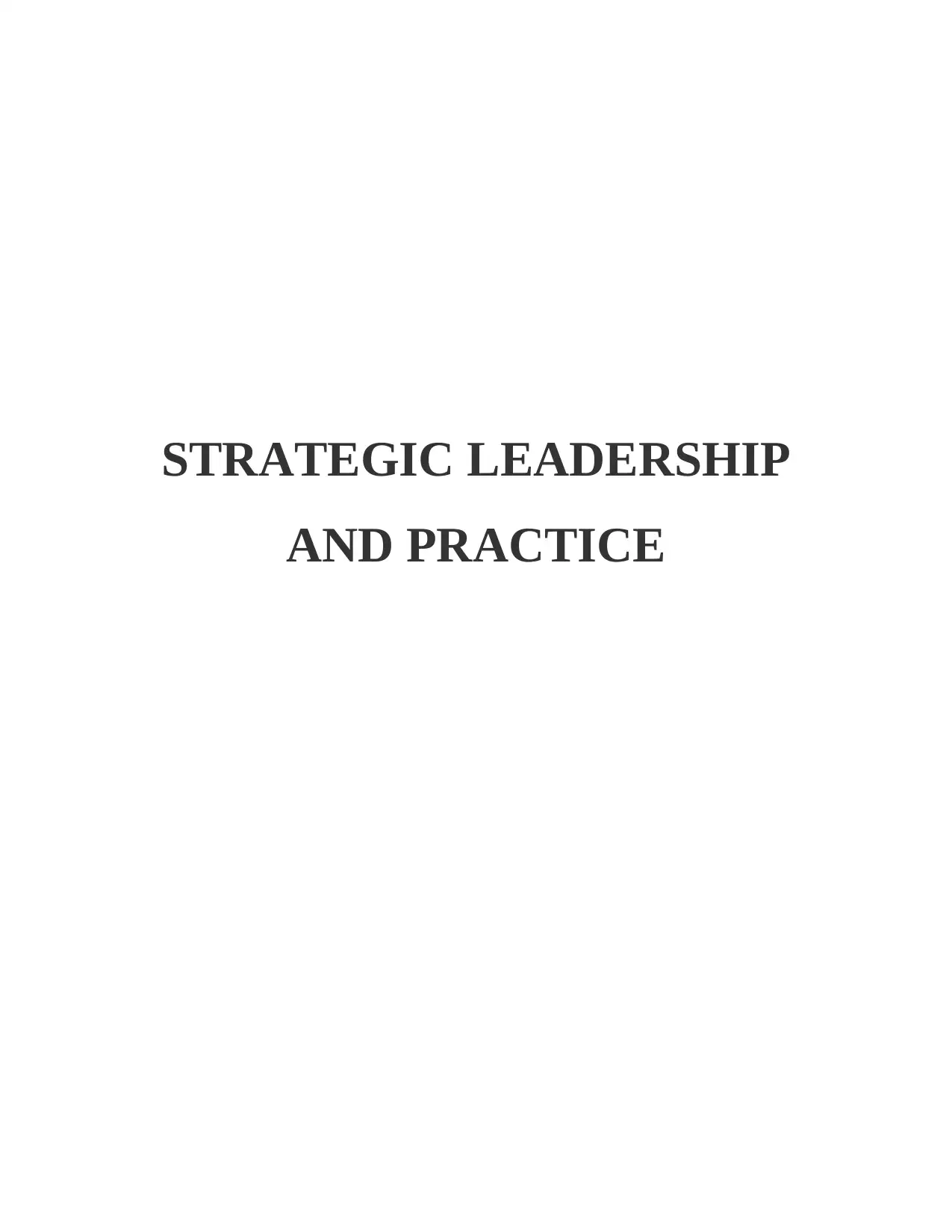
STRATEGIC LEADERSHIP
AND PRACTICE
AND PRACTICE
Paraphrase This Document
Need a fresh take? Get an instant paraphrase of this document with our AI Paraphraser
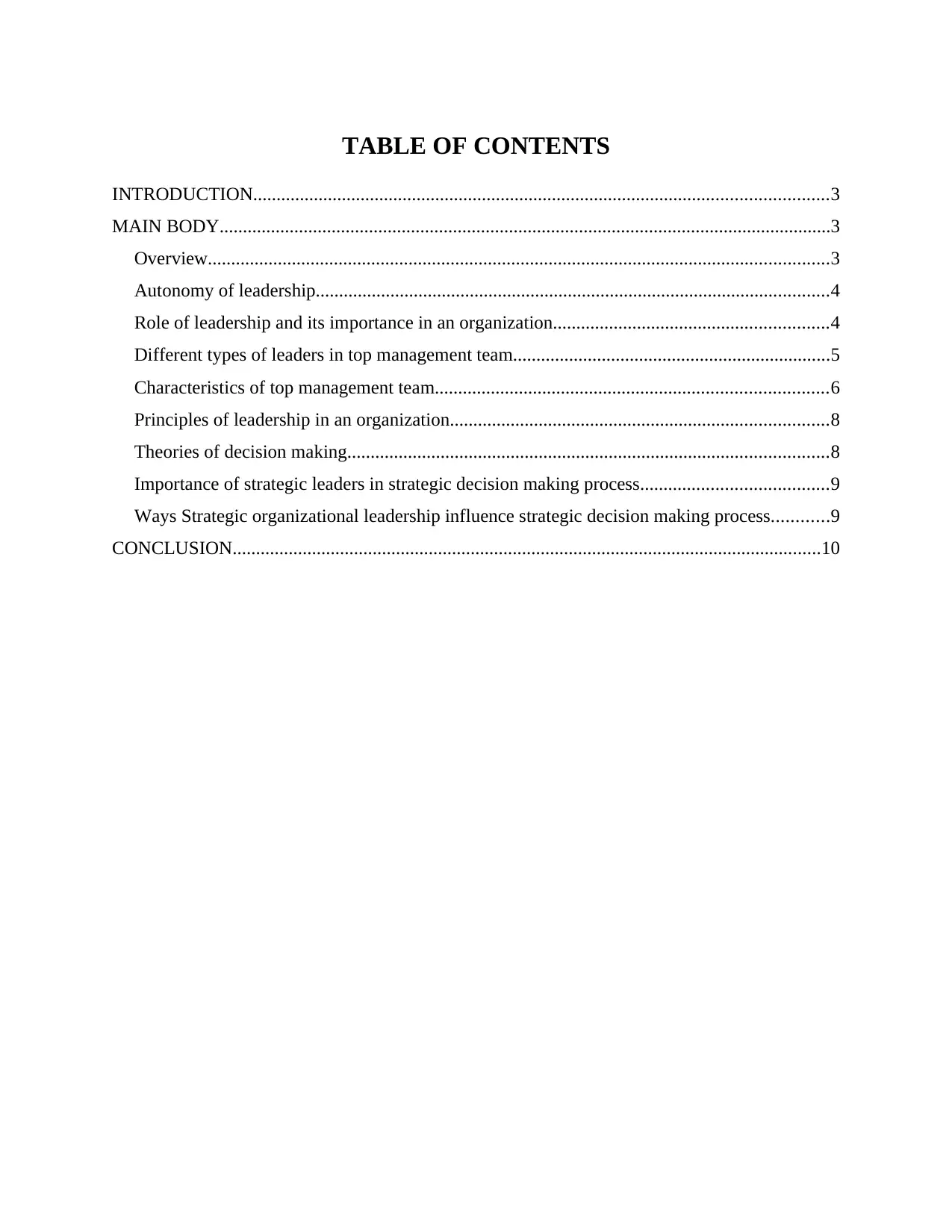
TABLE OF CONTENTS
INTRODUCTION...........................................................................................................................3
MAIN BODY...................................................................................................................................3
Overview.....................................................................................................................................3
Autonomy of leadership..............................................................................................................4
Role of leadership and its importance in an organization...........................................................4
Different types of leaders in top management team....................................................................5
Characteristics of top management team....................................................................................6
Principles of leadership in an organization.................................................................................8
Theories of decision making.......................................................................................................8
Importance of strategic leaders in strategic decision making process........................................9
Ways Strategic organizational leadership influence strategic decision making process............9
CONCLUSION..............................................................................................................................10
INTRODUCTION...........................................................................................................................3
MAIN BODY...................................................................................................................................3
Overview.....................................................................................................................................3
Autonomy of leadership..............................................................................................................4
Role of leadership and its importance in an organization...........................................................4
Different types of leaders in top management team....................................................................5
Characteristics of top management team....................................................................................6
Principles of leadership in an organization.................................................................................8
Theories of decision making.......................................................................................................8
Importance of strategic leaders in strategic decision making process........................................9
Ways Strategic organizational leadership influence strategic decision making process............9
CONCLUSION..............................................................................................................................10
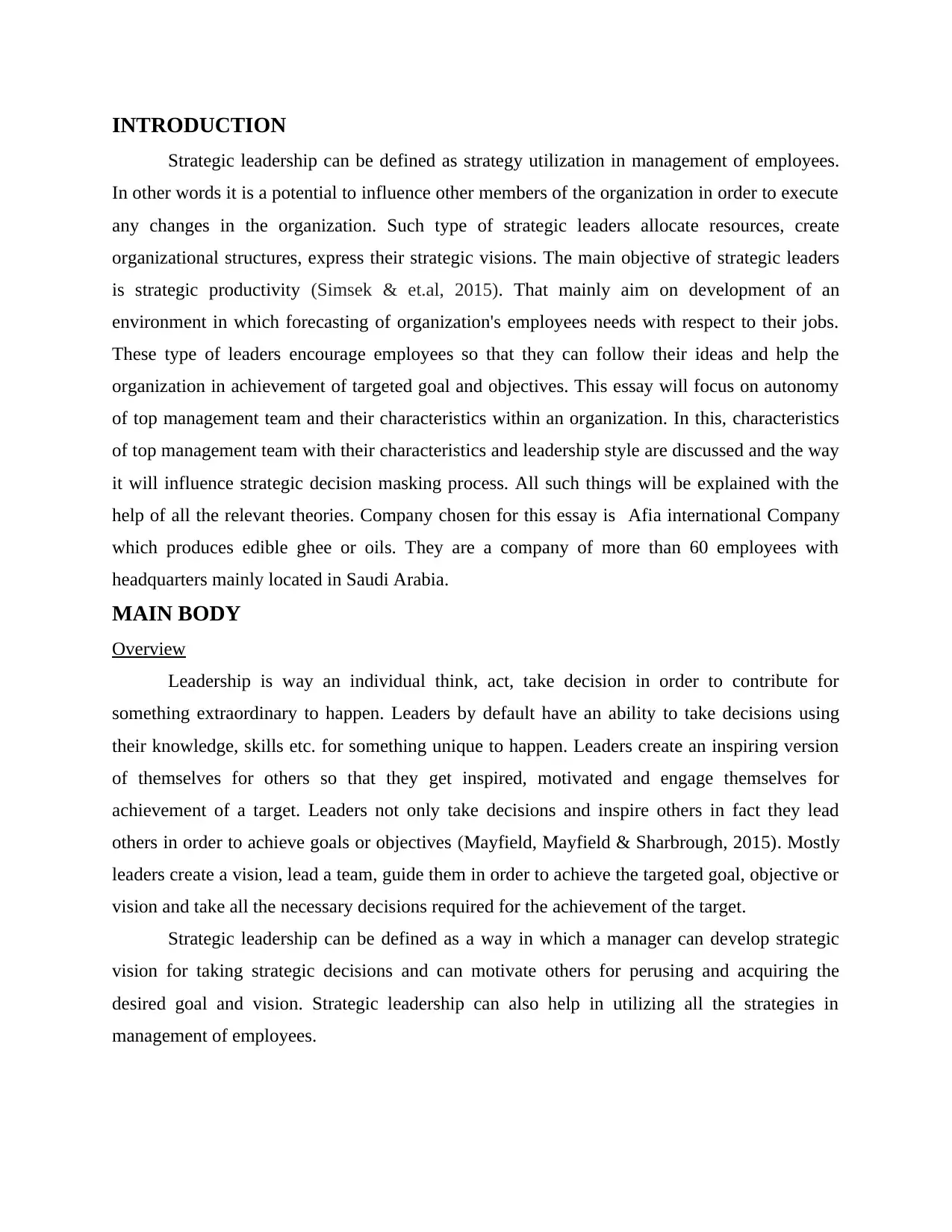
INTRODUCTION
Strategic leadership can be defined as strategy utilization in management of employees.
In other words it is a potential to influence other members of the organization in order to execute
any changes in the organization. Such type of strategic leaders allocate resources, create
organizational structures, express their strategic visions. The main objective of strategic leaders
is strategic productivity (Simsek & et.al, 2015). That mainly aim on development of an
environment in which forecasting of organization's employees needs with respect to their jobs.
These type of leaders encourage employees so that they can follow their ideas and help the
organization in achievement of targeted goal and objectives. This essay will focus on autonomy
of top management team and their characteristics within an organization. In this, characteristics
of top management team with their characteristics and leadership style are discussed and the way
it will influence strategic decision masking process. All such things will be explained with the
help of all the relevant theories. Company chosen for this essay is Afia international Company
which produces edible ghee or oils. They are a company of more than 60 employees with
headquarters mainly located in Saudi Arabia.
MAIN BODY
Overview
Leadership is way an individual think, act, take decision in order to contribute for
something extraordinary to happen. Leaders by default have an ability to take decisions using
their knowledge, skills etc. for something unique to happen. Leaders create an inspiring version
of themselves for others so that they get inspired, motivated and engage themselves for
achievement of a target. Leaders not only take decisions and inspire others in fact they lead
others in order to achieve goals or objectives (Mayfield, Mayfield & Sharbrough, 2015). Mostly
leaders create a vision, lead a team, guide them in order to achieve the targeted goal, objective or
vision and take all the necessary decisions required for the achievement of the target.
Strategic leadership can be defined as a way in which a manager can develop strategic
vision for taking strategic decisions and can motivate others for perusing and acquiring the
desired goal and vision. Strategic leadership can also help in utilizing all the strategies in
management of employees.
Strategic leadership can be defined as strategy utilization in management of employees.
In other words it is a potential to influence other members of the organization in order to execute
any changes in the organization. Such type of strategic leaders allocate resources, create
organizational structures, express their strategic visions. The main objective of strategic leaders
is strategic productivity (Simsek & et.al, 2015). That mainly aim on development of an
environment in which forecasting of organization's employees needs with respect to their jobs.
These type of leaders encourage employees so that they can follow their ideas and help the
organization in achievement of targeted goal and objectives. This essay will focus on autonomy
of top management team and their characteristics within an organization. In this, characteristics
of top management team with their characteristics and leadership style are discussed and the way
it will influence strategic decision masking process. All such things will be explained with the
help of all the relevant theories. Company chosen for this essay is Afia international Company
which produces edible ghee or oils. They are a company of more than 60 employees with
headquarters mainly located in Saudi Arabia.
MAIN BODY
Overview
Leadership is way an individual think, act, take decision in order to contribute for
something extraordinary to happen. Leaders by default have an ability to take decisions using
their knowledge, skills etc. for something unique to happen. Leaders create an inspiring version
of themselves for others so that they get inspired, motivated and engage themselves for
achievement of a target. Leaders not only take decisions and inspire others in fact they lead
others in order to achieve goals or objectives (Mayfield, Mayfield & Sharbrough, 2015). Mostly
leaders create a vision, lead a team, guide them in order to achieve the targeted goal, objective or
vision and take all the necessary decisions required for the achievement of the target.
Strategic leadership can be defined as a way in which a manager can develop strategic
vision for taking strategic decisions and can motivate others for perusing and acquiring the
desired goal and vision. Strategic leadership can also help in utilizing all the strategies in
management of employees.
⊘ This is a preview!⊘
Do you want full access?
Subscribe today to unlock all pages.

Trusted by 1+ million students worldwide
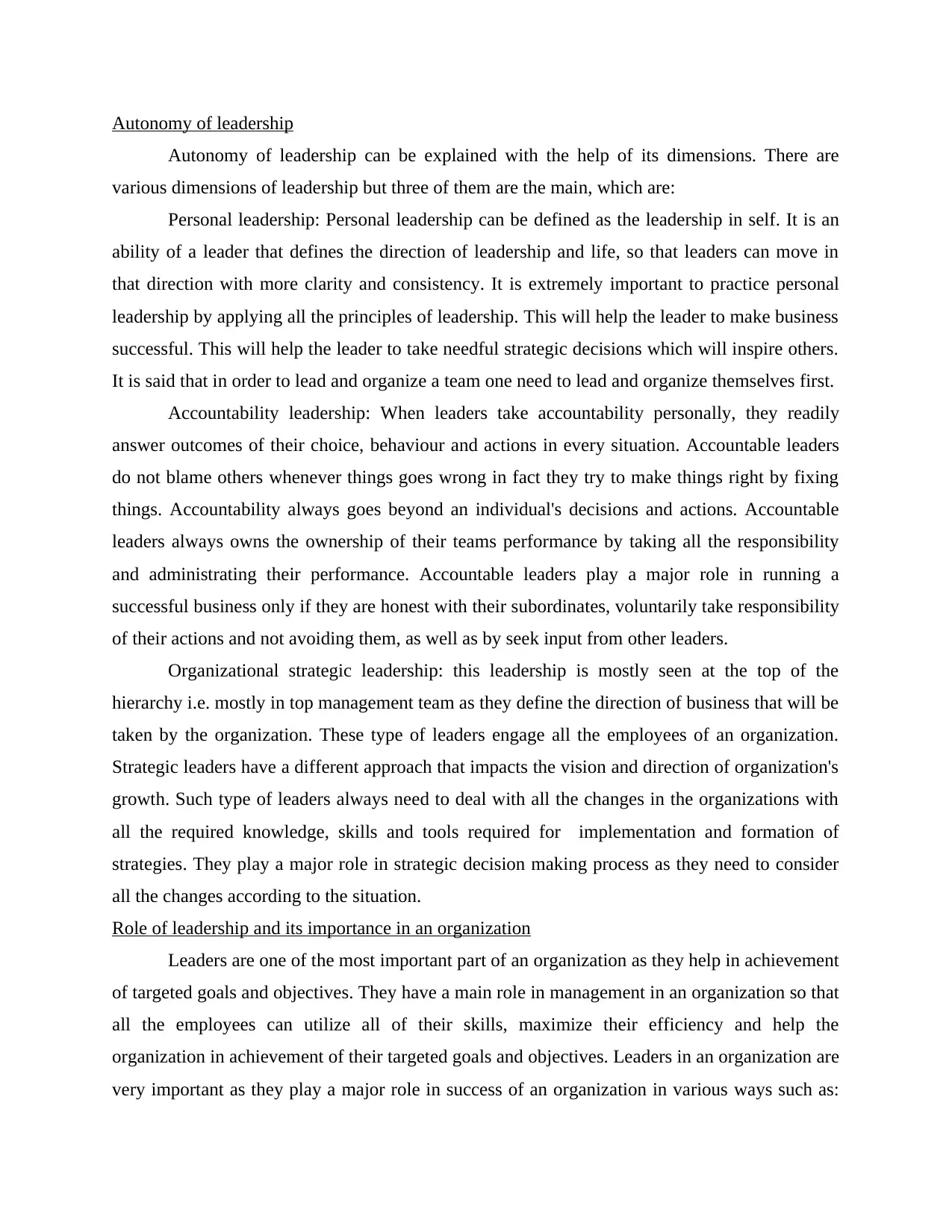
Autonomy of leadership
Autonomy of leadership can be explained with the help of its dimensions. There are
various dimensions of leadership but three of them are the main, which are:
Personal leadership: Personal leadership can be defined as the leadership in self. It is an
ability of a leader that defines the direction of leadership and life, so that leaders can move in
that direction with more clarity and consistency. It is extremely important to practice personal
leadership by applying all the principles of leadership. This will help the leader to make business
successful. This will help the leader to take needful strategic decisions which will inspire others.
It is said that in order to lead and organize a team one need to lead and organize themselves first.
Accountability leadership: When leaders take accountability personally, they readily
answer outcomes of their choice, behaviour and actions in every situation. Accountable leaders
do not blame others whenever things goes wrong in fact they try to make things right by fixing
things. Accountability always goes beyond an individual's decisions and actions. Accountable
leaders always owns the ownership of their teams performance by taking all the responsibility
and administrating their performance. Accountable leaders play a major role in running a
successful business only if they are honest with their subordinates, voluntarily take responsibility
of their actions and not avoiding them, as well as by seek input from other leaders.
Organizational strategic leadership: this leadership is mostly seen at the top of the
hierarchy i.e. mostly in top management team as they define the direction of business that will be
taken by the organization. These type of leaders engage all the employees of an organization.
Strategic leaders have a different approach that impacts the vision and direction of organization's
growth. Such type of leaders always need to deal with all the changes in the organizations with
all the required knowledge, skills and tools required for implementation and formation of
strategies. They play a major role in strategic decision making process as they need to consider
all the changes according to the situation.
Role of leadership and its importance in an organization
Leaders are one of the most important part of an organization as they help in achievement
of targeted goals and objectives. They have a main role in management in an organization so that
all the employees can utilize all of their skills, maximize their efficiency and help the
organization in achievement of their targeted goals and objectives. Leaders in an organization are
very important as they play a major role in success of an organization in various ways such as:
Autonomy of leadership can be explained with the help of its dimensions. There are
various dimensions of leadership but three of them are the main, which are:
Personal leadership: Personal leadership can be defined as the leadership in self. It is an
ability of a leader that defines the direction of leadership and life, so that leaders can move in
that direction with more clarity and consistency. It is extremely important to practice personal
leadership by applying all the principles of leadership. This will help the leader to make business
successful. This will help the leader to take needful strategic decisions which will inspire others.
It is said that in order to lead and organize a team one need to lead and organize themselves first.
Accountability leadership: When leaders take accountability personally, they readily
answer outcomes of their choice, behaviour and actions in every situation. Accountable leaders
do not blame others whenever things goes wrong in fact they try to make things right by fixing
things. Accountability always goes beyond an individual's decisions and actions. Accountable
leaders always owns the ownership of their teams performance by taking all the responsibility
and administrating their performance. Accountable leaders play a major role in running a
successful business only if they are honest with their subordinates, voluntarily take responsibility
of their actions and not avoiding them, as well as by seek input from other leaders.
Organizational strategic leadership: this leadership is mostly seen at the top of the
hierarchy i.e. mostly in top management team as they define the direction of business that will be
taken by the organization. These type of leaders engage all the employees of an organization.
Strategic leaders have a different approach that impacts the vision and direction of organization's
growth. Such type of leaders always need to deal with all the changes in the organizations with
all the required knowledge, skills and tools required for implementation and formation of
strategies. They play a major role in strategic decision making process as they need to consider
all the changes according to the situation.
Role of leadership and its importance in an organization
Leaders are one of the most important part of an organization as they help in achievement
of targeted goals and objectives. They have a main role in management in an organization so that
all the employees can utilize all of their skills, maximize their efficiency and help the
organization in achievement of their targeted goals and objectives. Leaders in an organization are
very important as they play a major role in success of an organization in various ways such as:
Paraphrase This Document
Need a fresh take? Get an instant paraphrase of this document with our AI Paraphraser
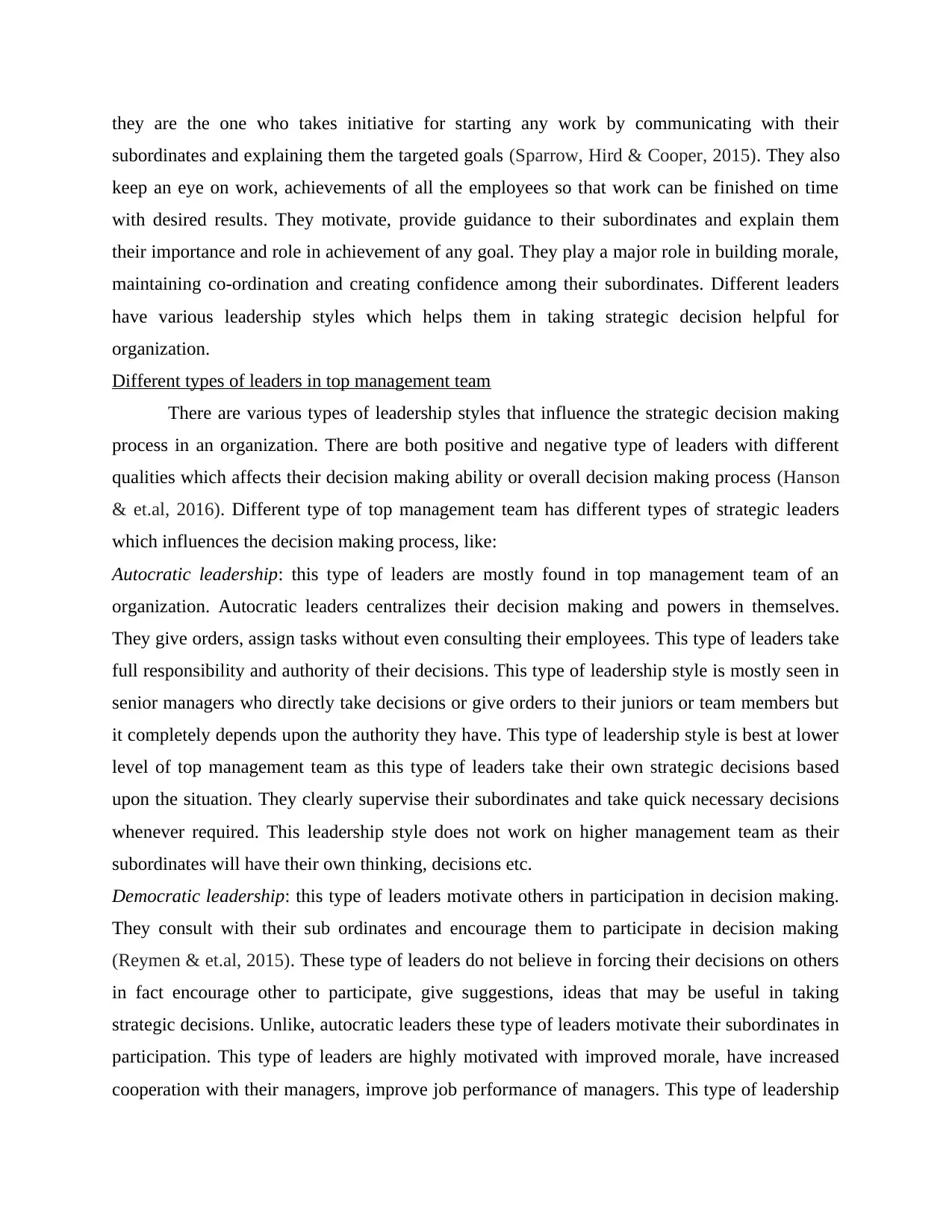
they are the one who takes initiative for starting any work by communicating with their
subordinates and explaining them the targeted goals (Sparrow, Hird & Cooper, 2015). They also
keep an eye on work, achievements of all the employees so that work can be finished on time
with desired results. They motivate, provide guidance to their subordinates and explain them
their importance and role in achievement of any goal. They play a major role in building morale,
maintaining co-ordination and creating confidence among their subordinates. Different leaders
have various leadership styles which helps them in taking strategic decision helpful for
organization.
Different types of leaders in top management team
There are various types of leadership styles that influence the strategic decision making
process in an organization. There are both positive and negative type of leaders with different
qualities which affects their decision making ability or overall decision making process (Hanson
& et.al, 2016). Different type of top management team has different types of strategic leaders
which influences the decision making process, like:
Autocratic leadership: this type of leaders are mostly found in top management team of an
organization. Autocratic leaders centralizes their decision making and powers in themselves.
They give orders, assign tasks without even consulting their employees. This type of leaders take
full responsibility and authority of their decisions. This type of leadership style is mostly seen in
senior managers who directly take decisions or give orders to their juniors or team members but
it completely depends upon the authority they have. This type of leadership style is best at lower
level of top management team as this type of leaders take their own strategic decisions based
upon the situation. They clearly supervise their subordinates and take quick necessary decisions
whenever required. This leadership style does not work on higher management team as their
subordinates will have their own thinking, decisions etc.
Democratic leadership: this type of leaders motivate others in participation in decision making.
They consult with their sub ordinates and encourage them to participate in decision making
(Reymen & et.al, 2015). These type of leaders do not believe in forcing their decisions on others
in fact encourage other to participate, give suggestions, ideas that may be useful in taking
strategic decisions. Unlike, autocratic leaders these type of leaders motivate their subordinates in
participation. This type of leaders are highly motivated with improved morale, have increased
cooperation with their managers, improve job performance of managers. This type of leadership
subordinates and explaining them the targeted goals (Sparrow, Hird & Cooper, 2015). They also
keep an eye on work, achievements of all the employees so that work can be finished on time
with desired results. They motivate, provide guidance to their subordinates and explain them
their importance and role in achievement of any goal. They play a major role in building morale,
maintaining co-ordination and creating confidence among their subordinates. Different leaders
have various leadership styles which helps them in taking strategic decision helpful for
organization.
Different types of leaders in top management team
There are various types of leadership styles that influence the strategic decision making
process in an organization. There are both positive and negative type of leaders with different
qualities which affects their decision making ability or overall decision making process (Hanson
& et.al, 2016). Different type of top management team has different types of strategic leaders
which influences the decision making process, like:
Autocratic leadership: this type of leaders are mostly found in top management team of an
organization. Autocratic leaders centralizes their decision making and powers in themselves.
They give orders, assign tasks without even consulting their employees. This type of leaders take
full responsibility and authority of their decisions. This type of leadership style is mostly seen in
senior managers who directly take decisions or give orders to their juniors or team members but
it completely depends upon the authority they have. This type of leadership style is best at lower
level of top management team as this type of leaders take their own strategic decisions based
upon the situation. They clearly supervise their subordinates and take quick necessary decisions
whenever required. This leadership style does not work on higher management team as their
subordinates will have their own thinking, decisions etc.
Democratic leadership: this type of leaders motivate others in participation in decision making.
They consult with their sub ordinates and encourage them to participate in decision making
(Reymen & et.al, 2015). These type of leaders do not believe in forcing their decisions on others
in fact encourage other to participate, give suggestions, ideas that may be useful in taking
strategic decisions. Unlike, autocratic leaders these type of leaders motivate their subordinates in
participation. This type of leaders are highly motivated with improved morale, have increased
cooperation with their managers, improve job performance of managers. This type of leadership
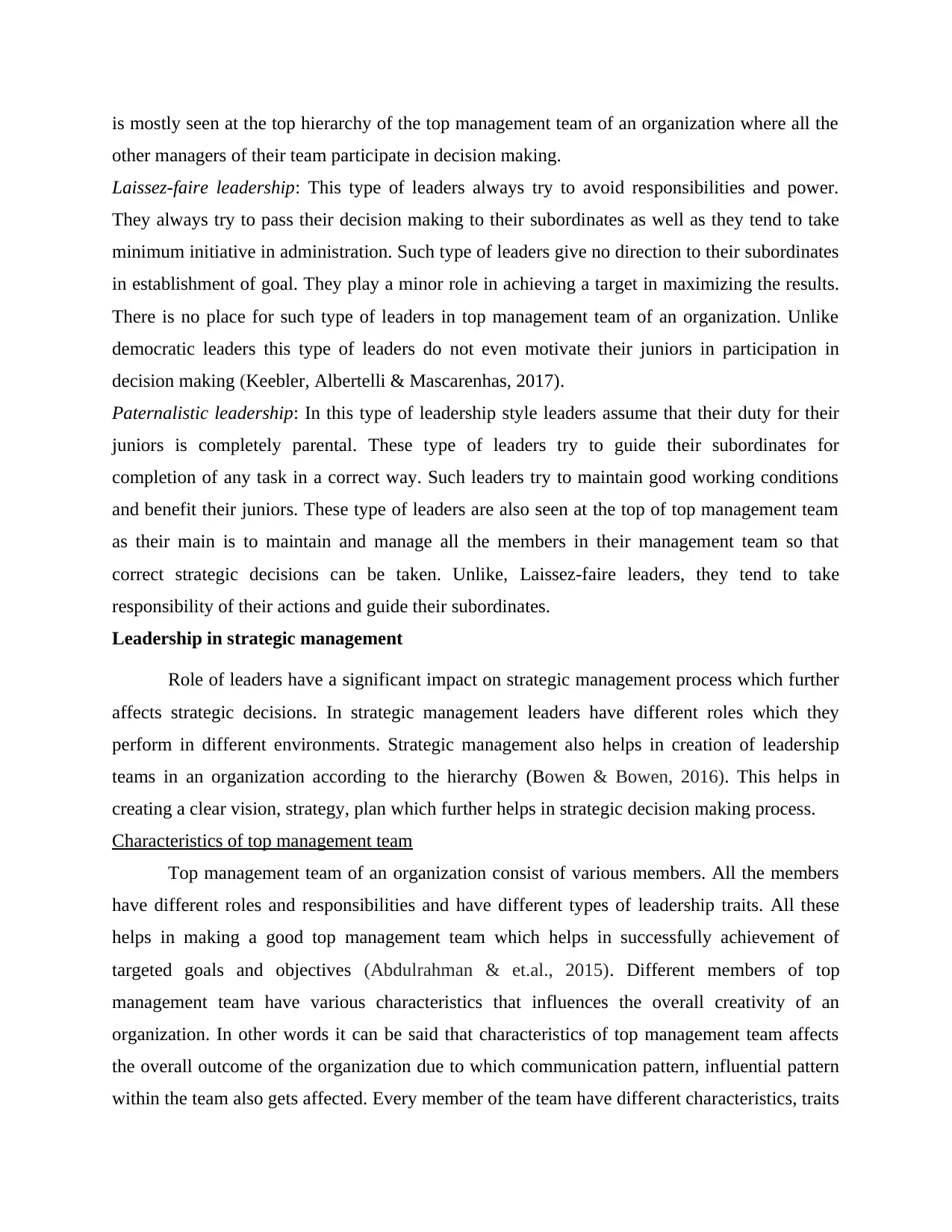
is mostly seen at the top hierarchy of the top management team of an organization where all the
other managers of their team participate in decision making.
Laissez-faire leadership: This type of leaders always try to avoid responsibilities and power.
They always try to pass their decision making to their subordinates as well as they tend to take
minimum initiative in administration. Such type of leaders give no direction to their subordinates
in establishment of goal. They play a minor role in achieving a target in maximizing the results.
There is no place for such type of leaders in top management team of an organization. Unlike
democratic leaders this type of leaders do not even motivate their juniors in participation in
decision making (Keebler, Albertelli & Mascarenhas, 2017).
Paternalistic leadership: In this type of leadership style leaders assume that their duty for their
juniors is completely parental. These type of leaders try to guide their subordinates for
completion of any task in a correct way. Such leaders try to maintain good working conditions
and benefit their juniors. These type of leaders are also seen at the top of top management team
as their main is to maintain and manage all the members in their management team so that
correct strategic decisions can be taken. Unlike, Laissez-faire leaders, they tend to take
responsibility of their actions and guide their subordinates.
Leadership in strategic management
Role of leaders have a significant impact on strategic management process which further
affects strategic decisions. In strategic management leaders have different roles which they
perform in different environments. Strategic management also helps in creation of leadership
teams in an organization according to the hierarchy (Bowen & Bowen, 2016). This helps in
creating a clear vision, strategy, plan which further helps in strategic decision making process.
Characteristics of top management team
Top management team of an organization consist of various members. All the members
have different roles and responsibilities and have different types of leadership traits. All these
helps in making a good top management team which helps in successfully achievement of
targeted goals and objectives (Abdulrahman & et.al., 2015). Different members of top
management team have various characteristics that influences the overall creativity of an
organization. In other words it can be said that characteristics of top management team affects
the overall outcome of the organization due to which communication pattern, influential pattern
within the team also gets affected. Every member of the team have different characteristics, traits
other managers of their team participate in decision making.
Laissez-faire leadership: This type of leaders always try to avoid responsibilities and power.
They always try to pass their decision making to their subordinates as well as they tend to take
minimum initiative in administration. Such type of leaders give no direction to their subordinates
in establishment of goal. They play a minor role in achieving a target in maximizing the results.
There is no place for such type of leaders in top management team of an organization. Unlike
democratic leaders this type of leaders do not even motivate their juniors in participation in
decision making (Keebler, Albertelli & Mascarenhas, 2017).
Paternalistic leadership: In this type of leadership style leaders assume that their duty for their
juniors is completely parental. These type of leaders try to guide their subordinates for
completion of any task in a correct way. Such leaders try to maintain good working conditions
and benefit their juniors. These type of leaders are also seen at the top of top management team
as their main is to maintain and manage all the members in their management team so that
correct strategic decisions can be taken. Unlike, Laissez-faire leaders, they tend to take
responsibility of their actions and guide their subordinates.
Leadership in strategic management
Role of leaders have a significant impact on strategic management process which further
affects strategic decisions. In strategic management leaders have different roles which they
perform in different environments. Strategic management also helps in creation of leadership
teams in an organization according to the hierarchy (Bowen & Bowen, 2016). This helps in
creating a clear vision, strategy, plan which further helps in strategic decision making process.
Characteristics of top management team
Top management team of an organization consist of various members. All the members
have different roles and responsibilities and have different types of leadership traits. All these
helps in making a good top management team which helps in successfully achievement of
targeted goals and objectives (Abdulrahman & et.al., 2015). Different members of top
management team have various characteristics that influences the overall creativity of an
organization. In other words it can be said that characteristics of top management team affects
the overall outcome of the organization due to which communication pattern, influential pattern
within the team also gets affected. Every member of the team have different characteristics, traits
⊘ This is a preview!⊘
Do you want full access?
Subscribe today to unlock all pages.

Trusted by 1+ million students worldwide
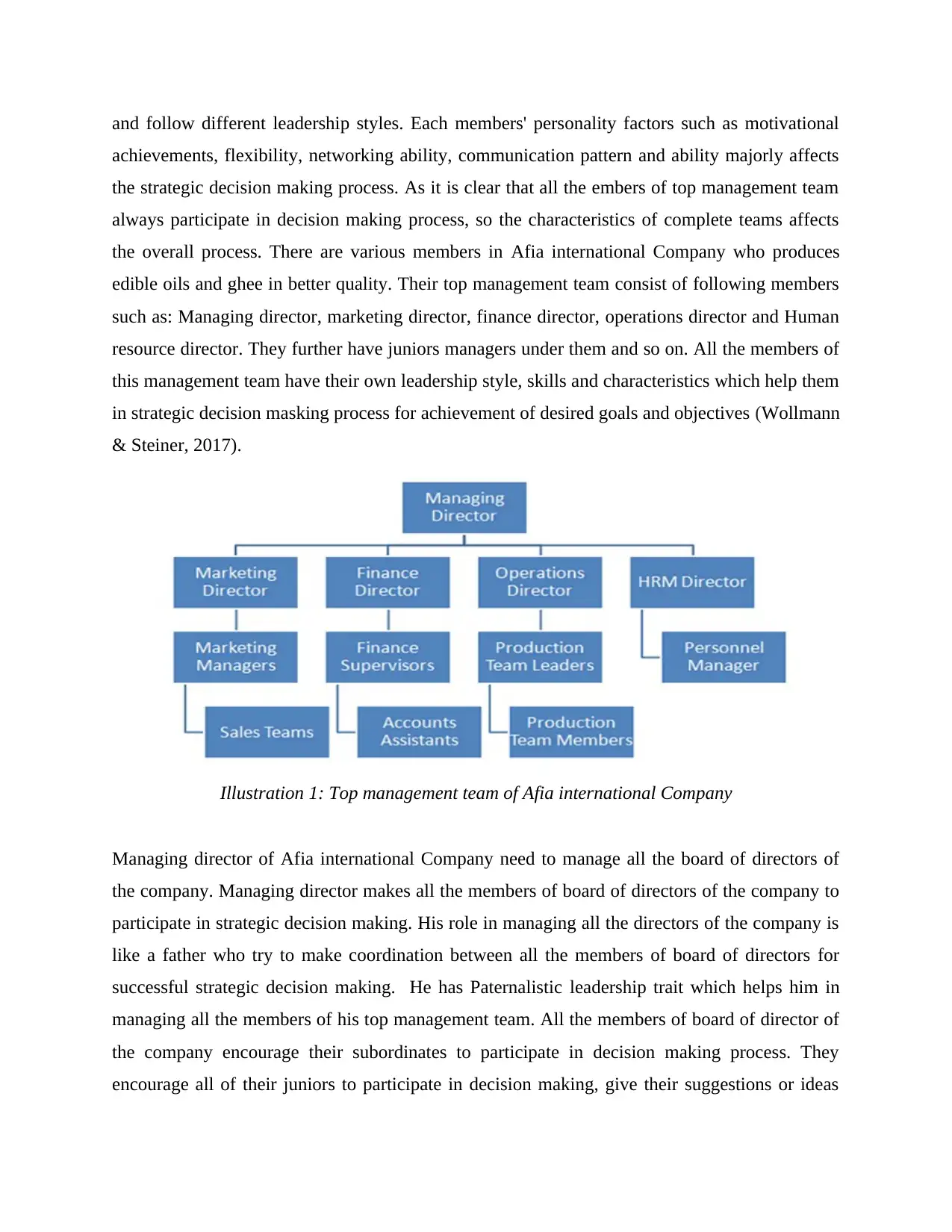
and follow different leadership styles. Each members' personality factors such as motivational
achievements, flexibility, networking ability, communication pattern and ability majorly affects
the strategic decision making process. As it is clear that all the embers of top management team
always participate in decision making process, so the characteristics of complete teams affects
the overall process. There are various members in Afia international Company who produces
edible oils and ghee in better quality. Their top management team consist of following members
such as: Managing director, marketing director, finance director, operations director and Human
resource director. They further have juniors managers under them and so on. All the members of
this management team have their own leadership style, skills and characteristics which help them
in strategic decision masking process for achievement of desired goals and objectives (Wollmann
& Steiner, 2017).
Managing director of Afia international Company need to manage all the board of directors of
the company. Managing director makes all the members of board of directors of the company to
participate in strategic decision making. His role in managing all the directors of the company is
like a father who try to make coordination between all the members of board of directors for
successful strategic decision making. He has Paternalistic leadership trait which helps him in
managing all the members of his top management team. All the members of board of director of
the company encourage their subordinates to participate in decision making process. They
encourage all of their juniors to participate in decision making, give their suggestions or ideas
Illustration 1: Top management team of Afia international Company
achievements, flexibility, networking ability, communication pattern and ability majorly affects
the strategic decision making process. As it is clear that all the embers of top management team
always participate in decision making process, so the characteristics of complete teams affects
the overall process. There are various members in Afia international Company who produces
edible oils and ghee in better quality. Their top management team consist of following members
such as: Managing director, marketing director, finance director, operations director and Human
resource director. They further have juniors managers under them and so on. All the members of
this management team have their own leadership style, skills and characteristics which help them
in strategic decision masking process for achievement of desired goals and objectives (Wollmann
& Steiner, 2017).
Managing director of Afia international Company need to manage all the board of directors of
the company. Managing director makes all the members of board of directors of the company to
participate in strategic decision making. His role in managing all the directors of the company is
like a father who try to make coordination between all the members of board of directors for
successful strategic decision making. He has Paternalistic leadership trait which helps him in
managing all the members of his top management team. All the members of board of director of
the company encourage their subordinates to participate in decision making process. They
encourage all of their juniors to participate in decision making, give their suggestions or ideas
Illustration 1: Top management team of Afia international Company
Paraphrase This Document
Need a fresh take? Get an instant paraphrase of this document with our AI Paraphraser
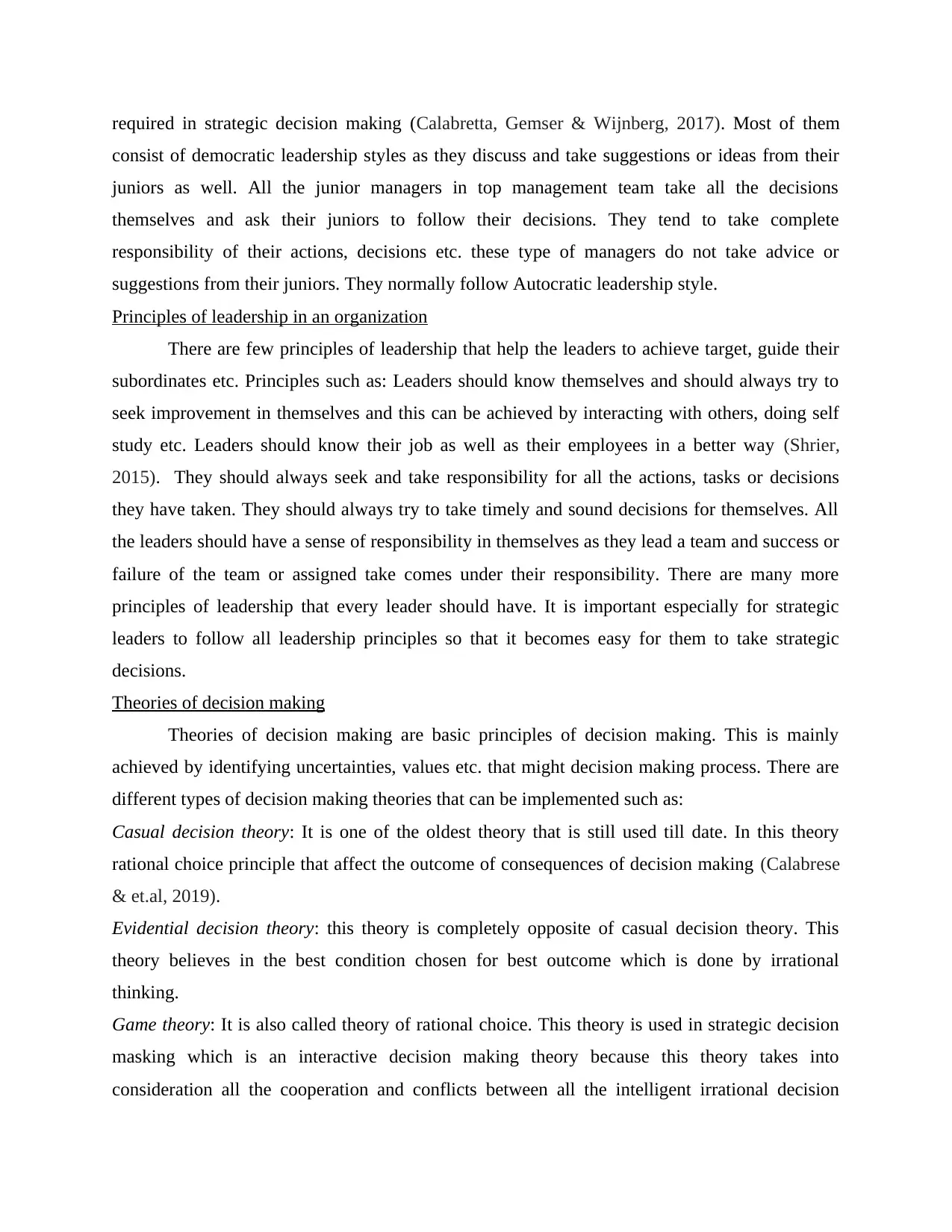
required in strategic decision making (Calabretta, Gemser & Wijnberg, 2017). Most of them
consist of democratic leadership styles as they discuss and take suggestions or ideas from their
juniors as well. All the junior managers in top management team take all the decisions
themselves and ask their juniors to follow their decisions. They tend to take complete
responsibility of their actions, decisions etc. these type of managers do not take advice or
suggestions from their juniors. They normally follow Autocratic leadership style.
Principles of leadership in an organization
There are few principles of leadership that help the leaders to achieve target, guide their
subordinates etc. Principles such as: Leaders should know themselves and should always try to
seek improvement in themselves and this can be achieved by interacting with others, doing self
study etc. Leaders should know their job as well as their employees in a better way (Shrier,
2015). They should always seek and take responsibility for all the actions, tasks or decisions
they have taken. They should always try to take timely and sound decisions for themselves. All
the leaders should have a sense of responsibility in themselves as they lead a team and success or
failure of the team or assigned take comes under their responsibility. There are many more
principles of leadership that every leader should have. It is important especially for strategic
leaders to follow all leadership principles so that it becomes easy for them to take strategic
decisions.
Theories of decision making
Theories of decision making are basic principles of decision making. This is mainly
achieved by identifying uncertainties, values etc. that might decision making process. There are
different types of decision making theories that can be implemented such as:
Casual decision theory: It is one of the oldest theory that is still used till date. In this theory
rational choice principle that affect the outcome of consequences of decision making (Calabrese
& et.al, 2019).
Evidential decision theory: this theory is completely opposite of casual decision theory. This
theory believes in the best condition chosen for best outcome which is done by irrational
thinking.
Game theory: It is also called theory of rational choice. This theory is used in strategic decision
masking which is an interactive decision making theory because this theory takes into
consideration all the cooperation and conflicts between all the intelligent irrational decision
consist of democratic leadership styles as they discuss and take suggestions or ideas from their
juniors as well. All the junior managers in top management team take all the decisions
themselves and ask their juniors to follow their decisions. They tend to take complete
responsibility of their actions, decisions etc. these type of managers do not take advice or
suggestions from their juniors. They normally follow Autocratic leadership style.
Principles of leadership in an organization
There are few principles of leadership that help the leaders to achieve target, guide their
subordinates etc. Principles such as: Leaders should know themselves and should always try to
seek improvement in themselves and this can be achieved by interacting with others, doing self
study etc. Leaders should know their job as well as their employees in a better way (Shrier,
2015). They should always seek and take responsibility for all the actions, tasks or decisions
they have taken. They should always try to take timely and sound decisions for themselves. All
the leaders should have a sense of responsibility in themselves as they lead a team and success or
failure of the team or assigned take comes under their responsibility. There are many more
principles of leadership that every leader should have. It is important especially for strategic
leaders to follow all leadership principles so that it becomes easy for them to take strategic
decisions.
Theories of decision making
Theories of decision making are basic principles of decision making. This is mainly
achieved by identifying uncertainties, values etc. that might decision making process. There are
different types of decision making theories that can be implemented such as:
Casual decision theory: It is one of the oldest theory that is still used till date. In this theory
rational choice principle that affect the outcome of consequences of decision making (Calabrese
& et.al, 2019).
Evidential decision theory: this theory is completely opposite of casual decision theory. This
theory believes in the best condition chosen for best outcome which is done by irrational
thinking.
Game theory: It is also called theory of rational choice. This theory is used in strategic decision
masking which is an interactive decision making theory because this theory takes into
consideration all the cooperation and conflicts between all the intelligent irrational decision
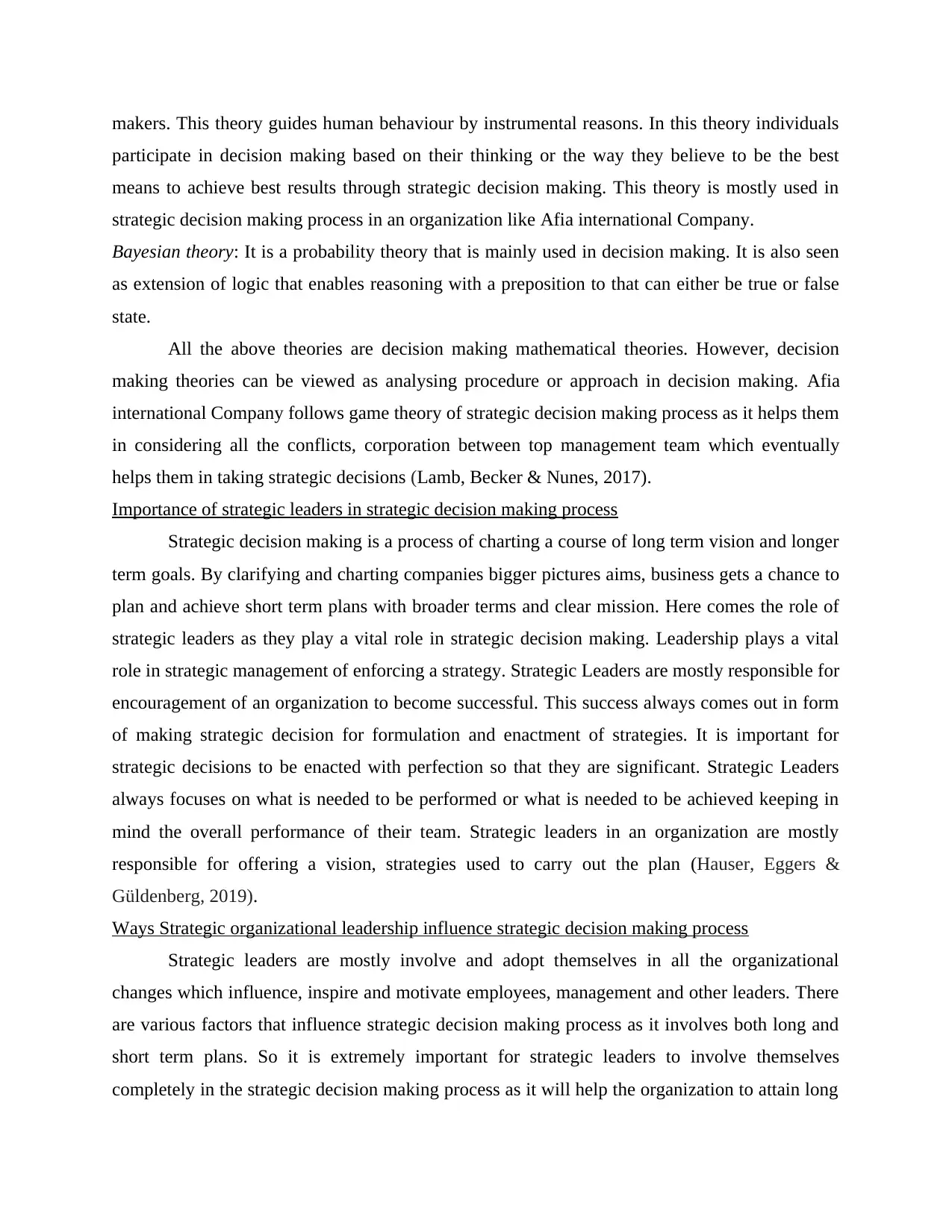
makers. This theory guides human behaviour by instrumental reasons. In this theory individuals
participate in decision making based on their thinking or the way they believe to be the best
means to achieve best results through strategic decision making. This theory is mostly used in
strategic decision making process in an organization like Afia international Company.
Bayesian theory: It is a probability theory that is mainly used in decision making. It is also seen
as extension of logic that enables reasoning with a preposition to that can either be true or false
state.
All the above theories are decision making mathematical theories. However, decision
making theories can be viewed as analysing procedure or approach in decision making. Afia
international Company follows game theory of strategic decision making process as it helps them
in considering all the conflicts, corporation between top management team which eventually
helps them in taking strategic decisions (Lamb, Becker & Nunes, 2017).
Importance of strategic leaders in strategic decision making process
Strategic decision making is a process of charting a course of long term vision and longer
term goals. By clarifying and charting companies bigger pictures aims, business gets a chance to
plan and achieve short term plans with broader terms and clear mission. Here comes the role of
strategic leaders as they play a vital role in strategic decision making. Leadership plays a vital
role in strategic management of enforcing a strategy. Strategic Leaders are mostly responsible for
encouragement of an organization to become successful. This success always comes out in form
of making strategic decision for formulation and enactment of strategies. It is important for
strategic decisions to be enacted with perfection so that they are significant. Strategic Leaders
always focuses on what is needed to be performed or what is needed to be achieved keeping in
mind the overall performance of their team. Strategic leaders in an organization are mostly
responsible for offering a vision, strategies used to carry out the plan (Hauser, Eggers &
Güldenberg, 2019).
Ways Strategic organizational leadership influence strategic decision making process
Strategic leaders are mostly involve and adopt themselves in all the organizational
changes which influence, inspire and motivate employees, management and other leaders. There
are various factors that influence strategic decision making process as it involves both long and
short term plans. So it is extremely important for strategic leaders to involve themselves
completely in the strategic decision making process as it will help the organization to attain long
participate in decision making based on their thinking or the way they believe to be the best
means to achieve best results through strategic decision making. This theory is mostly used in
strategic decision making process in an organization like Afia international Company.
Bayesian theory: It is a probability theory that is mainly used in decision making. It is also seen
as extension of logic that enables reasoning with a preposition to that can either be true or false
state.
All the above theories are decision making mathematical theories. However, decision
making theories can be viewed as analysing procedure or approach in decision making. Afia
international Company follows game theory of strategic decision making process as it helps them
in considering all the conflicts, corporation between top management team which eventually
helps them in taking strategic decisions (Lamb, Becker & Nunes, 2017).
Importance of strategic leaders in strategic decision making process
Strategic decision making is a process of charting a course of long term vision and longer
term goals. By clarifying and charting companies bigger pictures aims, business gets a chance to
plan and achieve short term plans with broader terms and clear mission. Here comes the role of
strategic leaders as they play a vital role in strategic decision making. Leadership plays a vital
role in strategic management of enforcing a strategy. Strategic Leaders are mostly responsible for
encouragement of an organization to become successful. This success always comes out in form
of making strategic decision for formulation and enactment of strategies. It is important for
strategic decisions to be enacted with perfection so that they are significant. Strategic Leaders
always focuses on what is needed to be performed or what is needed to be achieved keeping in
mind the overall performance of their team. Strategic leaders in an organization are mostly
responsible for offering a vision, strategies used to carry out the plan (Hauser, Eggers &
Güldenberg, 2019).
Ways Strategic organizational leadership influence strategic decision making process
Strategic leaders are mostly involve and adopt themselves in all the organizational
changes which influence, inspire and motivate employees, management and other leaders. There
are various factors that influence strategic decision making process as it involves both long and
short term plans. So it is extremely important for strategic leaders to involve themselves
completely in the strategic decision making process as it will help the organization to attain long
⊘ This is a preview!⊘
Do you want full access?
Subscribe today to unlock all pages.

Trusted by 1+ million students worldwide
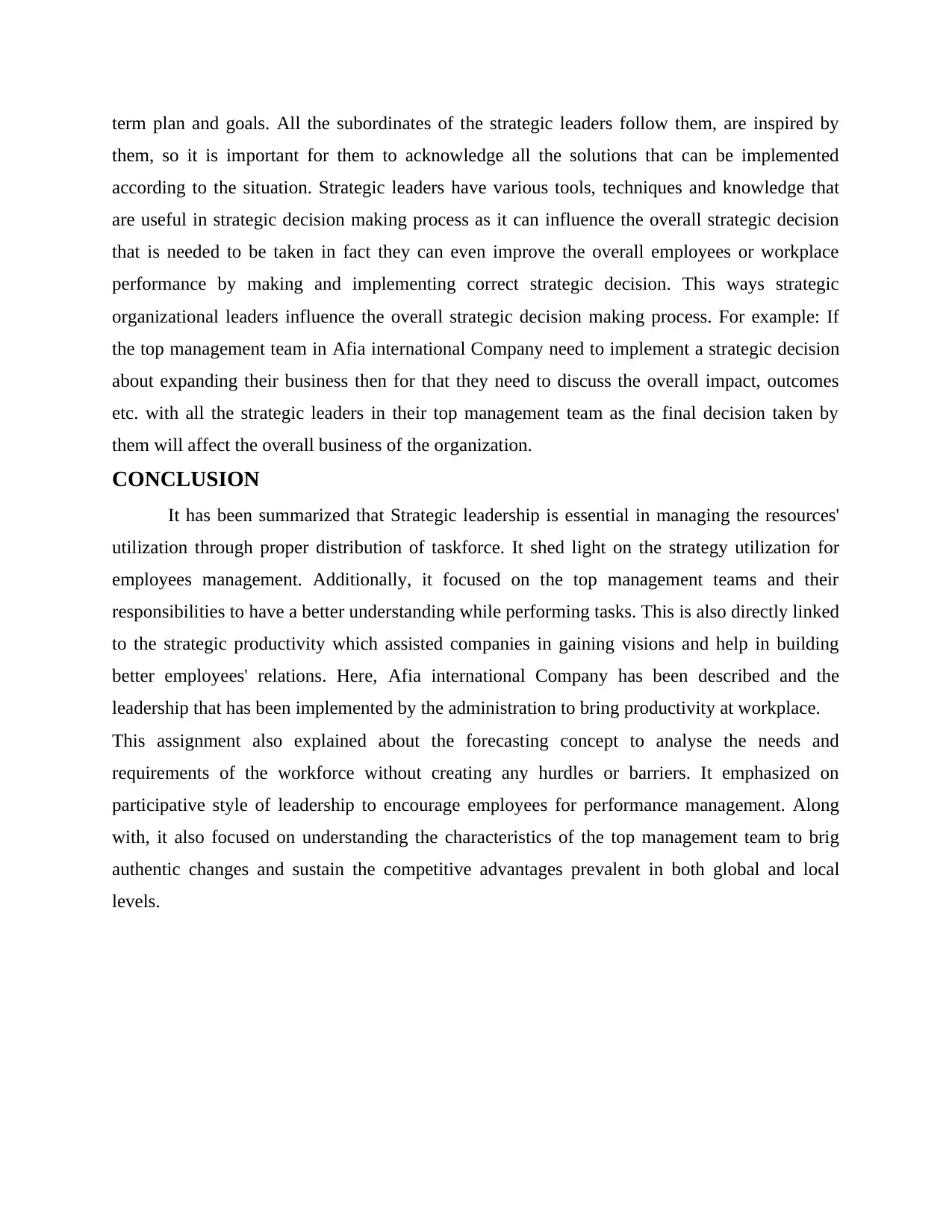
term plan and goals. All the subordinates of the strategic leaders follow them, are inspired by
them, so it is important for them to acknowledge all the solutions that can be implemented
according to the situation. Strategic leaders have various tools, techniques and knowledge that
are useful in strategic decision making process as it can influence the overall strategic decision
that is needed to be taken in fact they can even improve the overall employees or workplace
performance by making and implementing correct strategic decision. This ways strategic
organizational leaders influence the overall strategic decision making process. For example: If
the top management team in Afia international Company need to implement a strategic decision
about expanding their business then for that they need to discuss the overall impact, outcomes
etc. with all the strategic leaders in their top management team as the final decision taken by
them will affect the overall business of the organization.
CONCLUSION
It has been summarized that Strategic leadership is essential in managing the resources'
utilization through proper distribution of taskforce. It shed light on the strategy utilization for
employees management. Additionally, it focused on the top management teams and their
responsibilities to have a better understanding while performing tasks. This is also directly linked
to the strategic productivity which assisted companies in gaining visions and help in building
better employees' relations. Here, Afia international Company has been described and the
leadership that has been implemented by the administration to bring productivity at workplace.
This assignment also explained about the forecasting concept to analyse the needs and
requirements of the workforce without creating any hurdles or barriers. It emphasized on
participative style of leadership to encourage employees for performance management. Along
with, it also focused on understanding the characteristics of the top management team to brig
authentic changes and sustain the competitive advantages prevalent in both global and local
levels.
them, so it is important for them to acknowledge all the solutions that can be implemented
according to the situation. Strategic leaders have various tools, techniques and knowledge that
are useful in strategic decision making process as it can influence the overall strategic decision
that is needed to be taken in fact they can even improve the overall employees or workplace
performance by making and implementing correct strategic decision. This ways strategic
organizational leaders influence the overall strategic decision making process. For example: If
the top management team in Afia international Company need to implement a strategic decision
about expanding their business then for that they need to discuss the overall impact, outcomes
etc. with all the strategic leaders in their top management team as the final decision taken by
them will affect the overall business of the organization.
CONCLUSION
It has been summarized that Strategic leadership is essential in managing the resources'
utilization through proper distribution of taskforce. It shed light on the strategy utilization for
employees management. Additionally, it focused on the top management teams and their
responsibilities to have a better understanding while performing tasks. This is also directly linked
to the strategic productivity which assisted companies in gaining visions and help in building
better employees' relations. Here, Afia international Company has been described and the
leadership that has been implemented by the administration to bring productivity at workplace.
This assignment also explained about the forecasting concept to analyse the needs and
requirements of the workforce without creating any hurdles or barriers. It emphasized on
participative style of leadership to encourage employees for performance management. Along
with, it also focused on understanding the characteristics of the top management team to brig
authentic changes and sustain the competitive advantages prevalent in both global and local
levels.
Paraphrase This Document
Need a fresh take? Get an instant paraphrase of this document with our AI Paraphraser
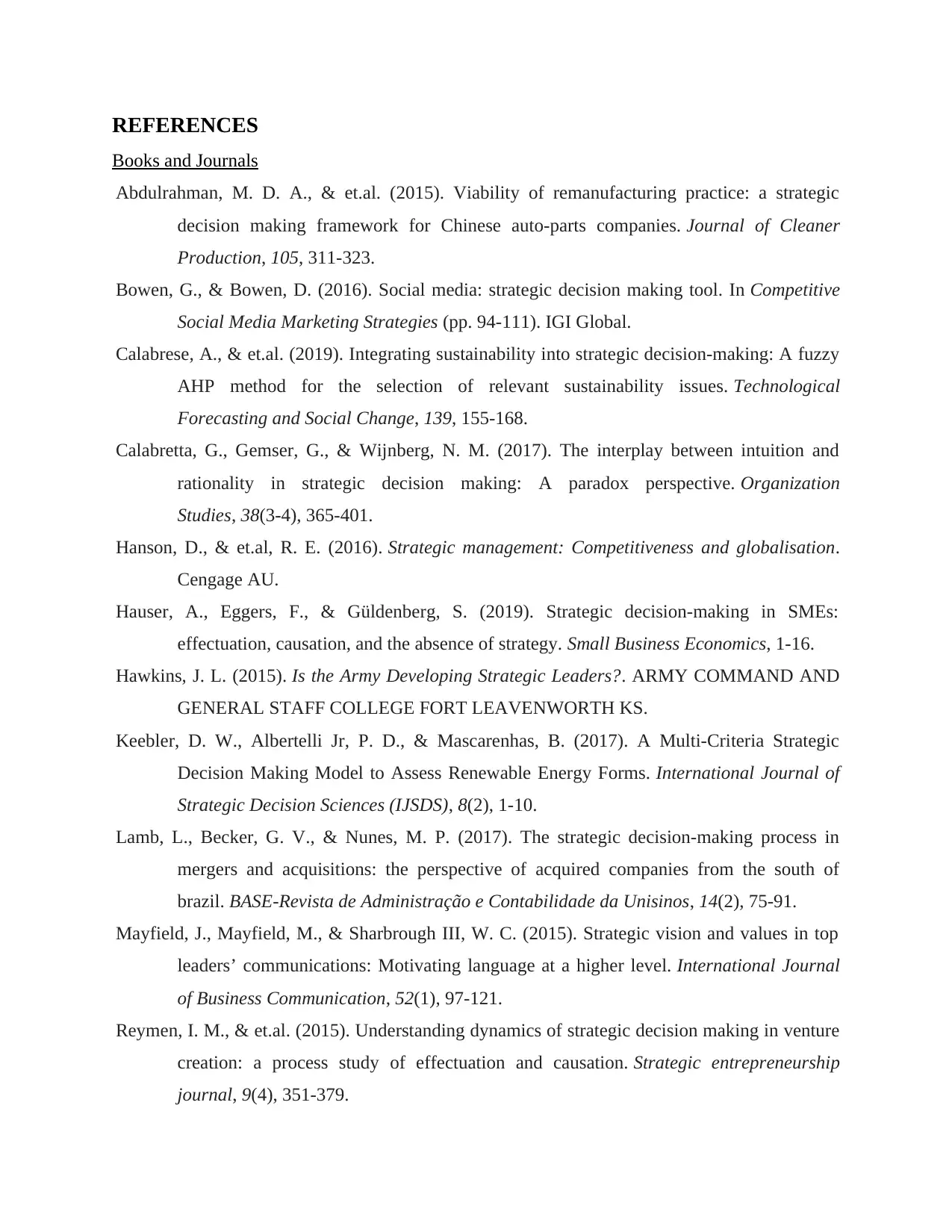
REFERENCES
Books and Journals
Abdulrahman, M. D. A., & et.al. (2015). Viability of remanufacturing practice: a strategic
decision making framework for Chinese auto-parts companies. Journal of Cleaner
Production, 105, 311-323.
Bowen, G., & Bowen, D. (2016). Social media: strategic decision making tool. In Competitive
Social Media Marketing Strategies (pp. 94-111). IGI Global.
Calabrese, A., & et.al. (2019). Integrating sustainability into strategic decision-making: A fuzzy
AHP method for the selection of relevant sustainability issues. Technological
Forecasting and Social Change, 139, 155-168.
Calabretta, G., Gemser, G., & Wijnberg, N. M. (2017). The interplay between intuition and
rationality in strategic decision making: A paradox perspective. Organization
Studies, 38(3-4), 365-401.
Hanson, D., & et.al, R. E. (2016). Strategic management: Competitiveness and globalisation.
Cengage AU.
Hauser, A., Eggers, F., & Güldenberg, S. (2019). Strategic decision-making in SMEs:
effectuation, causation, and the absence of strategy. Small Business Economics, 1-16.
Hawkins, J. L. (2015). Is the Army Developing Strategic Leaders?. ARMY COMMAND AND
GENERAL STAFF COLLEGE FORT LEAVENWORTH KS.
Keebler, D. W., Albertelli Jr, P. D., & Mascarenhas, B. (2017). A Multi-Criteria Strategic
Decision Making Model to Assess Renewable Energy Forms. International Journal of
Strategic Decision Sciences (IJSDS), 8(2), 1-10.
Lamb, L., Becker, G. V., & Nunes, M. P. (2017). The strategic decision-making process in
mergers and acquisitions: the perspective of acquired companies from the south of
brazil. BASE-Revista de Administração e Contabilidade da Unisinos, 14(2), 75-91.
Mayfield, J., Mayfield, M., & Sharbrough III, W. C. (2015). Strategic vision and values in top
leaders’ communications: Motivating language at a higher level. International Journal
of Business Communication, 52(1), 97-121.
Reymen, I. M., & et.al. (2015). Understanding dynamics of strategic decision making in venture
creation: a process study of effectuation and causation. Strategic entrepreneurship
journal, 9(4), 351-379.
Books and Journals
Abdulrahman, M. D. A., & et.al. (2015). Viability of remanufacturing practice: a strategic
decision making framework for Chinese auto-parts companies. Journal of Cleaner
Production, 105, 311-323.
Bowen, G., & Bowen, D. (2016). Social media: strategic decision making tool. In Competitive
Social Media Marketing Strategies (pp. 94-111). IGI Global.
Calabrese, A., & et.al. (2019). Integrating sustainability into strategic decision-making: A fuzzy
AHP method for the selection of relevant sustainability issues. Technological
Forecasting and Social Change, 139, 155-168.
Calabretta, G., Gemser, G., & Wijnberg, N. M. (2017). The interplay between intuition and
rationality in strategic decision making: A paradox perspective. Organization
Studies, 38(3-4), 365-401.
Hanson, D., & et.al, R. E. (2016). Strategic management: Competitiveness and globalisation.
Cengage AU.
Hauser, A., Eggers, F., & Güldenberg, S. (2019). Strategic decision-making in SMEs:
effectuation, causation, and the absence of strategy. Small Business Economics, 1-16.
Hawkins, J. L. (2015). Is the Army Developing Strategic Leaders?. ARMY COMMAND AND
GENERAL STAFF COLLEGE FORT LEAVENWORTH KS.
Keebler, D. W., Albertelli Jr, P. D., & Mascarenhas, B. (2017). A Multi-Criteria Strategic
Decision Making Model to Assess Renewable Energy Forms. International Journal of
Strategic Decision Sciences (IJSDS), 8(2), 1-10.
Lamb, L., Becker, G. V., & Nunes, M. P. (2017). The strategic decision-making process in
mergers and acquisitions: the perspective of acquired companies from the south of
brazil. BASE-Revista de Administração e Contabilidade da Unisinos, 14(2), 75-91.
Mayfield, J., Mayfield, M., & Sharbrough III, W. C. (2015). Strategic vision and values in top
leaders’ communications: Motivating language at a higher level. International Journal
of Business Communication, 52(1), 97-121.
Reymen, I. M., & et.al. (2015). Understanding dynamics of strategic decision making in venture
creation: a process study of effectuation and causation. Strategic entrepreneurship
journal, 9(4), 351-379.
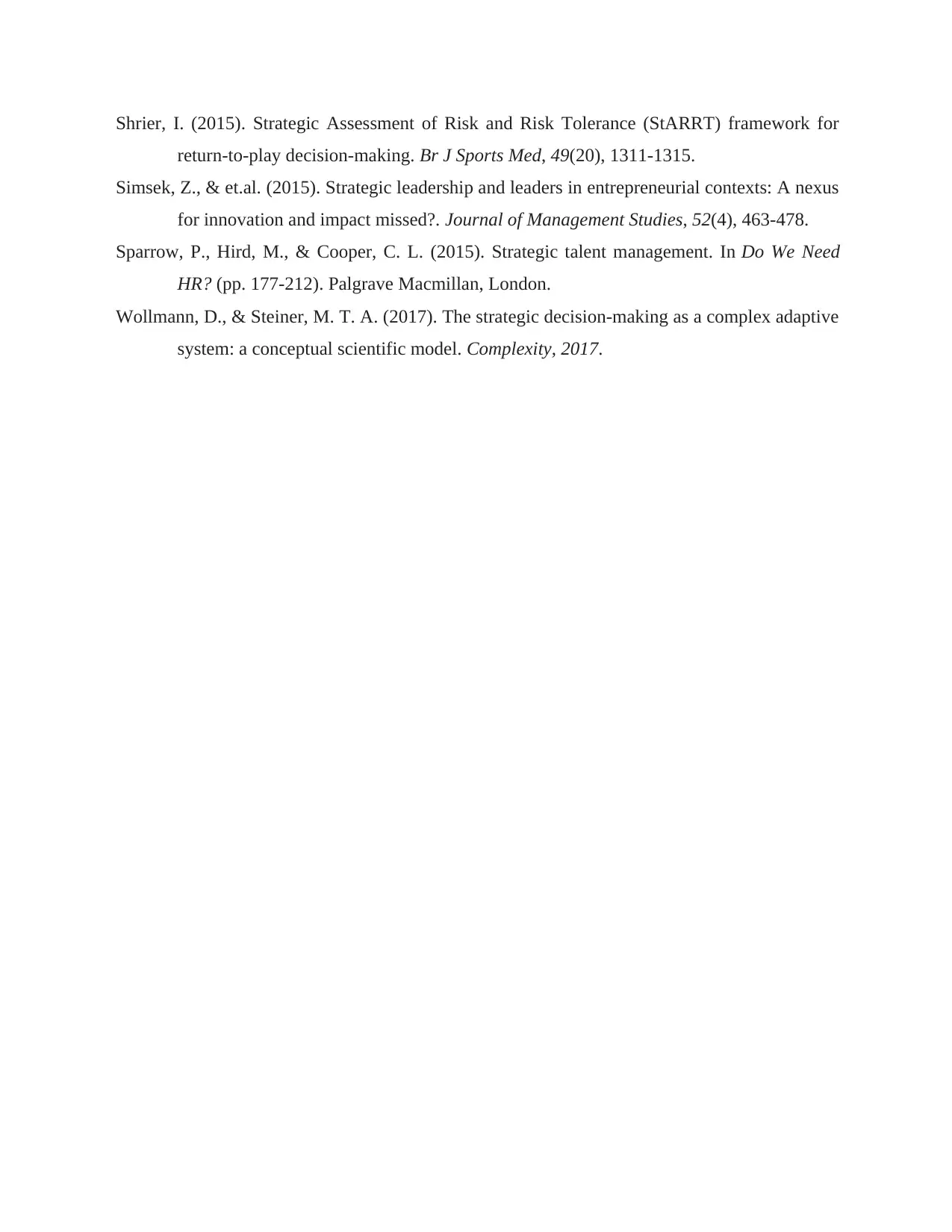
Shrier, I. (2015). Strategic Assessment of Risk and Risk Tolerance (StARRT) framework for
return-to-play decision-making. Br J Sports Med, 49(20), 1311-1315.
Simsek, Z., & et.al. (2015). Strategic leadership and leaders in entrepreneurial contexts: A nexus
for innovation and impact missed?. Journal of Management Studies, 52(4), 463-478.
Sparrow, P., Hird, M., & Cooper, C. L. (2015). Strategic talent management. In Do We Need
HR? (pp. 177-212). Palgrave Macmillan, London.
Wollmann, D., & Steiner, M. T. A. (2017). The strategic decision-making as a complex adaptive
system: a conceptual scientific model. Complexity, 2017.
return-to-play decision-making. Br J Sports Med, 49(20), 1311-1315.
Simsek, Z., & et.al. (2015). Strategic leadership and leaders in entrepreneurial contexts: A nexus
for innovation and impact missed?. Journal of Management Studies, 52(4), 463-478.
Sparrow, P., Hird, M., & Cooper, C. L. (2015). Strategic talent management. In Do We Need
HR? (pp. 177-212). Palgrave Macmillan, London.
Wollmann, D., & Steiner, M. T. A. (2017). The strategic decision-making as a complex adaptive
system: a conceptual scientific model. Complexity, 2017.
⊘ This is a preview!⊘
Do you want full access?
Subscribe today to unlock all pages.

Trusted by 1+ million students worldwide
1 out of 12
Related Documents
Your All-in-One AI-Powered Toolkit for Academic Success.
+13062052269
info@desklib.com
Available 24*7 on WhatsApp / Email
![[object Object]](/_next/static/media/star-bottom.7253800d.svg)
Unlock your academic potential
Copyright © 2020–2025 A2Z Services. All Rights Reserved. Developed and managed by ZUCOL.




